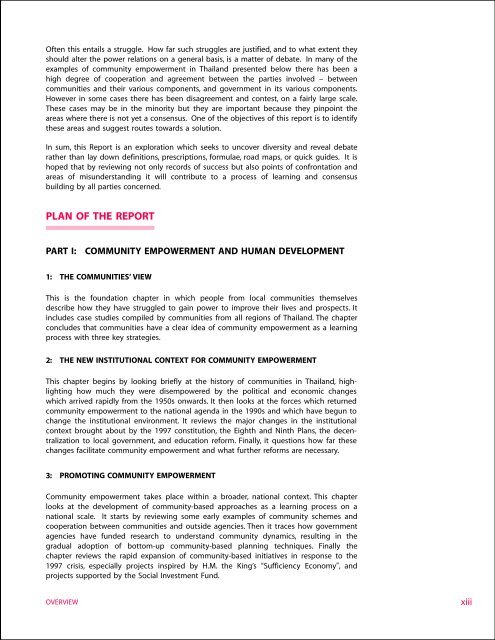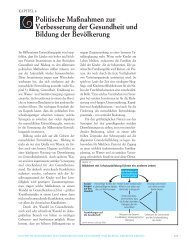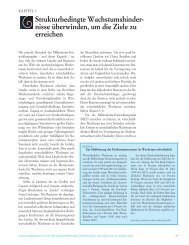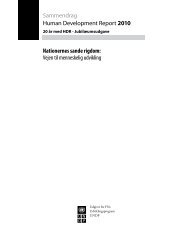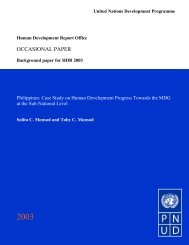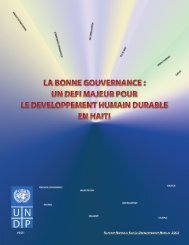THAILAND HUMAN DEVELOPMENT REPORT 2003
THAILAND HUMAN DEVELOPMENT REPORT 2003
THAILAND HUMAN DEVELOPMENT REPORT 2003
Create successful ePaper yourself
Turn your PDF publications into a flip-book with our unique Google optimized e-Paper software.
Often this entails a struggle. How far such struggles are justified, and to what extent they<br />
should alter the power relations on a general basis, is a matter of debate. In many of the<br />
examples of community empowerment in Thailand presented below there has been a<br />
high degree of cooperation and agreement between the parties involved – between<br />
communities and their various components, and government in its various components.<br />
However in some cases there has been disagreement and contest, on a fairly large scale.<br />
These cases may be in the minority but they are important because they pinpoint the<br />
areas where there is not yet a consensus. One of the objectives of this report is to identify<br />
these areas and suggest routes towards a solution.<br />
In sum, this Report is an exploration which seeks to uncover diversity and reveal debate<br />
rather than lay down definitions, prescriptions, formulae, road maps, or quick guides. It is<br />
hoped that by reviewing not only records of success but also points of confrontation and<br />
areas of misunderstanding it will contribute to a process of learning and consensus<br />
building by all parties concerned.<br />
PLAN OF THE <strong>REPORT</strong><br />
PART I: COMMUNITY EMPOWERMENT AND <strong>HUMAN</strong> <strong>DEVELOPMENT</strong><br />
1: THE COMMUNITIES’ VIEW<br />
This is the foundation chapter in which people from local communities themselves<br />
describe how they have struggled to gain power to improve their lives and prospects. It<br />
includes case studies compiled by communities from all regions of Thailand. The chapter<br />
concludes that communities have a clear idea of community empowerment as a learning<br />
process with three key strategies.<br />
2: THE NEW INSTITUTIONAL CONTEXT FOR COMMUNITY EMPOWERMENT<br />
This chapter begins by looking briefly at the history of communities in Thailand, highlighting<br />
how much they were disempowered by the political and economic changes<br />
which arrived rapidly from the 1950s onwards. It then looks at the forces which returned<br />
community empowerment to the national agenda in the 1990s and which have begun to<br />
change the institutional environment. It reviews the major changes in the institutional<br />
context brought about by the 1997 constitution, the Eighth and Ninth Plans, the decentralization<br />
to local government, and education reform. Finally, it questions how far these<br />
changes facilitate community empowerment and what further reforms are necessary.<br />
3: PROMOTING COMMUNITY EMPOWERMENT<br />
Community empowerment takes place within a broader, national context. This chapter<br />
looks at the development of community-based approaches as a learning process on a<br />
national scale. It starts by reviewing some early examples of community schemes and<br />
cooperation between communities and outside agencies. Then it traces how government<br />
agencies have funded research to understand community dynamics, resulting in the<br />
gradual adoption of bottom-up community-based planning techniques. Finally the<br />
chapter reviews the rapid expansion of community-based initiatives in response to the<br />
1997 crisis, especially projects inspired by H.M. the King’s “Sufficiency Economy”, and<br />
projects supported by the Social Investment Fund.<br />
OVERVIEW<br />
xiii


